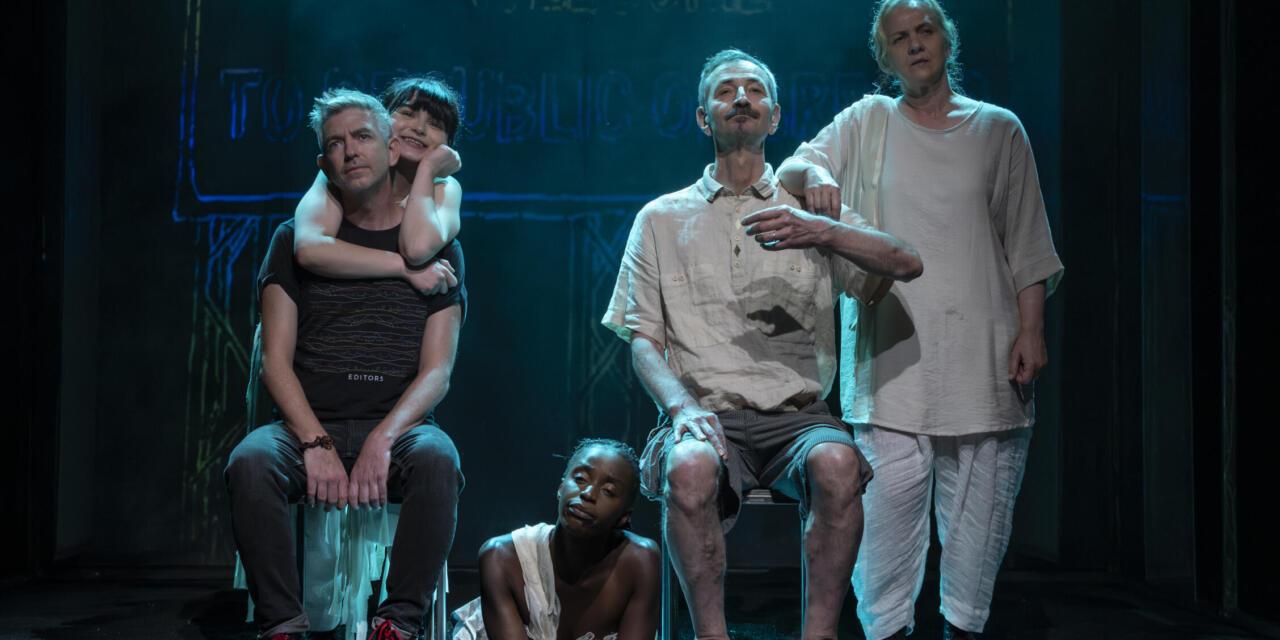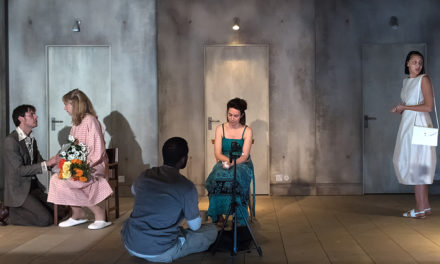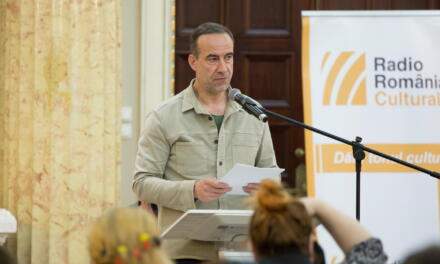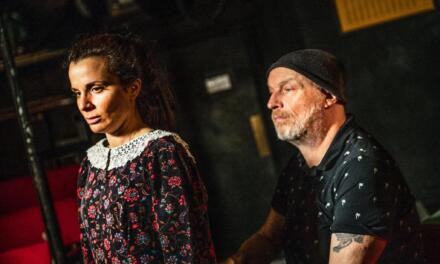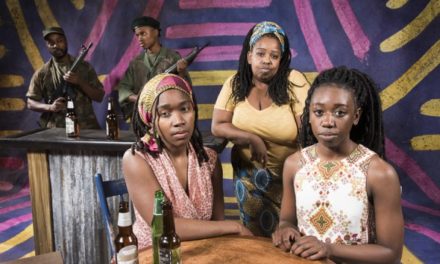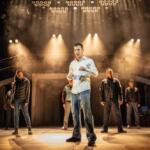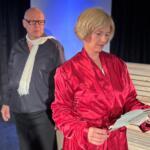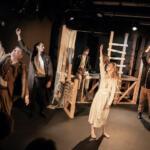The Flowers of Srebrenica should be impossible to stage. Irish academic Aidan Hehir’s book, a narrative account of visiting Srebrenica (now a Memorial Centre), where the UN left thousands of Bosnian Muslim men and boys to be tortured and slaughtered by Bosnian Serb soldiers, and countless more women and girls to be raped, defies genre definition. Part road movie, part trauma diary, part confessional, written and peppered with dry wit, it strikes an unnerving, jangling chord throughout its tersely written sentences. Its narrative focuses on the slightly dangerous, nerve-racking drive (at least for Hehir) to Srebrenica and his attempts to bond with Mustafa, his driver and guide, who fought against the Bosnian Serbs and was/ is directly affected by Srebrenica. Then the rest is a record of Hehir wrestling with his emotions at finally seeing the site of the killings – now an exhibition space documenting the massacre – about which he has only ever read and studied from afar – and challenging his own Irish background and history.
This staging by LegalAliens Theatre and Sarajevo War Theatre SARTR, which marks the thirtieth anniversary of the Bosnian genocide and has premiered in the Balkans and in London, is not a faithful translation, and deliberately so. It is clear that Lara Parmiani, who directs and has co-dramatised the book with Becka McFadden, is using the text as a starting point, not as somewhere to end up.
It is set in two important locations, which are staged at the same time. Designer Isabella Van Braeckel, in Cheng Keng’s dark light and Jovana Backovič’s bristling sound, envelops the whole play within the skeletal framework of a metal structure, mindful of a former hangar, or hut, of the kind where people are imprisoned and tortured. This metal or iron-like cage, which denotes the playing space, is there the whole time, as is a heap of black soil – the Bosnian Serbs reburied the bodies of the victims of Srebrenica time and again to prevent them from being discovered. Three women (Selma Alispahić, Taz Munyaneza and Valeriia Poholsha) who are like a chorus, scrabble around carefully in the soil and retrieve a black sandal. Mustafa (Edin Suljić) takes the sandal and slips it on, fleshing out his role – Hehir (Jeremiah O’Connor) and he meet – (after Hehir surfaces from within the audience), and the journey to Srebrenica gets underway.
Or does it? Because the sense of Srebrenica and those buildings where the horrors took place, which now make up the Memorial Centre, are already staged and remain a constant presence. Mustafa and Hehir may therefore, get into the car – physicalised by the women, who seem to voice Hehir’s inner anxieties and provide narrative comment – and, in front of Edalia Day’s animated and sparse back projections (inspired by the illustrations in the book by project graphics), they may seem to travel somewhere – but in a way, they don’t. They are already at Srebrenica, and so is the audience. In fact, the show and the audience are probably “at” every genocide possible. The constant presence of the soil reinforces this, as does the conjuring up of Mustafa from it – even now, Bosnians are finding bodies buried in the earth who died in the massacre. The point is that genocides like Srebrenica can never go away; they just repeat. In this sense, they can’t really be travelled to, nor travelled from.
So what journey are we going on then? It is that of Hehir’s, of his perceptions of Mustafa, of his struggles to communicate with him, of the world he finds himself in – new territory where there’s no manual explaining how to respond on an emotional level or how to navigate the relationship with Mustafa. What can one say to someone like Mustafa, who is as calm and as possessed as Hehir is nervous and distressed? How can anything be said?
This is not to say that this is a deep dive into Hehir’s personal memories at the expense of the genocide’s victims or history; it’s not “them and us” as such divisions are popularly characterised. Clearly, Hehir and Mustafa, played in such a nuanced way by the actors, seek to communicate with each other and find common ground. Parmiani also carefully and with nuance, gives centre stage to the genocide without shoving it in your face. In fact, it is gently introduced. One such instance is when Hehir and Mustafa finally arrive. Hehir alights from the car and immediately takes photos of the buildings. In this context, this would normally be jarring to the audience and something to criticise – but the buildings here are played by the chorus. So Hehir is photographing real people, not man-made structures. It’s a reminder that when one takes photos in places like this, or perhaps even anywhere, that one is never “just” photographing a building, but a history of people and events. Buildings, even empty ruined ones, are people.
Theatre can do this. It can conjure up such simple images and present ideas all at once and with clarity. We are asked, What are we doing when we visit such a place? What are we taking a photograph of, really? And when the women slide perspex slats across the stage, looking like mirrors, is Hehir then brought to face himself and his own country’s history? Another striking idea comes later too – the three women, who represent war and atrocities that have happened in their own countries, are now like children, and play in the soil together. Suddenly, one of them stands up and screams, as if the soil has done this, and the other two freeze, as if ruptured from the earth forever. It’s too easy to say that this is about young children losing their innocence, being caught up in such atrocities. No, it’s about how people’s perceptions of things so wonderful and so natural as soil, which, after all, gives life and is supposed to nurture, can be changed forever in our imaginations in cruel ways through the act of war and genocide. The soil suffers ecocide. The humans, genocide.
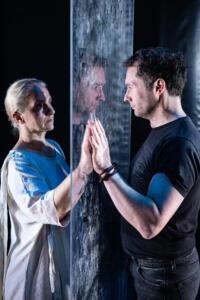
Jeremiah O’Connor as Aidan Hehir (in London) & Selma Alispahic, photo credit Addwood Mahoozi
The piece, like the book, is awkward to watch, uncomfortable, jerky. Don’t expect a smooth, glossy perfectly rhythmic historical text. It never sets out to be an explainer of war or genocide; its purpose is not to dissect how Srebrenica happened – it lays recognisable markers down from its first breath to point this out. It is also more than a memorial piece. It does ask different and difficult questions – such as, what can be gained from travelling thousands of miles to places like the Memorial Centre, and what can be learned? It asks how experiences of something so horrific can be communicated to those who have never experienced them – it focuses on how common ground can be found, not what divides such people. But it does not do this by centring Hehir’ story, and at points where Hehir seems to sink into his own thoughts and feelings he is recused by humour and reality- such as near the end, when Hehir proclaims with emotion that he wants “to do something” and one of the women asks him, with a straight face, to buy a souvenir from the nearby shop. It’s funny, yes, but it is also necessary for the locals to survive. It also earths Hehir, connects him to something real and tangible and helps him deal with his distress. It’s a great moment. Theatre can heal in this way if it shows how we can help one another deal with overwhelming emotions, avoid criticism, avoid judgment and practise kindness.
But “I want to do something” is also answered by the very existence of this play. And as Mustafa’s sandals are returned to the soil at the play’s end and the chorus retreat from whence they came, and Hehir and Mustafa stand away from the structure as just men now, just actors, this “I want to do something” surely has to become “what can we do?” This sentiment must echo in our minds as we read the hundreds of names of the victims of genocide from the most recent and ongoing to deep into the past.
One of the performances held a post-show discussion, and a question to be discussed was how theatre can help or contribute to the healing process. It is a big question, but surely it has to be linked to “I want to do something”, and in a way, the play is part of the answer.
The Flowers of Srebrenica is on tour in Norway and Italy now. See here for details
This post was written by the author in their personal capacity.The opinions expressed in this article are the author’s own and do not reflect the view of The Theatre Times, their staff or collaborators.
This post was written by Verity Healey.
The views expressed here belong to the author and do not necessarily reflect our views and opinions.

